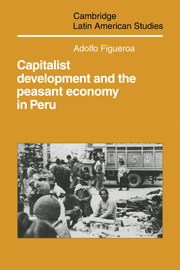Book contents
- Frontmatter
- Contents
- List of tables and figures
- Acknowledgments
- 1 Introduction
- 2 Scope and method
- 3 The economic unit and economic organization
- 4 Production and exchange
- 5 The level and structure of peasant income
- 6 The economic behavior of the peasant family
- 7 Stagnation in the peasant economy and the role of demand
- 8 Economic crisis and the peasant economy, 1975–1980
- 9 Conclusions: reality, theory and policy
- Appendixes
- Notes
- Bibliograph
- Index
- CAMBRIDGE LATIN AMERICAN STUDIES
5 - The level and structure of peasant income
Published online by Cambridge University Press: 04 August 2010
- Frontmatter
- Contents
- List of tables and figures
- Acknowledgments
- 1 Introduction
- 2 Scope and method
- 3 The economic unit and economic organization
- 4 Production and exchange
- 5 The level and structure of peasant income
- 6 The economic behavior of the peasant family
- 7 Stagnation in the peasant economy and the role of demand
- 8 Economic crisis and the peasant economy, 1975–1980
- 9 Conclusions: reality, theory and policy
- Appendixes
- Notes
- Bibliograph
- Index
- CAMBRIDGE LATIN AMERICAN STUDIES
Summary
The information presented in the previous chapter concerning intersectoral relations in peasant communities now permits us to arrive at estimates of the level and structure of income in those communities. In this way we estimate total peasant income based on previous understanding of the peasant economy.
The level of total peasant income
One way of calculating peasant income is to consider the value (at market prices) of consumption and investment. As net peasant production is dedicated in part to home consumption and in part to trade, income may be defined as the sum of total consumption and investment, from which the net balance of external exchange must be subtracted. As the value of exports (including transfers) is equal to the value of imports, a second alternative for measuring income is to add to home consumption the value of exports (which would give the net product of A + P + Z) and then the value of income from temporary migrations. From this sum we would have to deduct the value of imports of intermediate products which were used to obtain the net product A + P + Z. Of course, here we are using the terms imports and exports to refer to goods purchased or sold outside the community.
The third method of calculating income is by way of value added. The estimations of total product A + P + Z and of inputs (domestic and imported) permit us to make this calculation, since the value added is the difference between these two figures.
- Type
- Chapter
- Information
- Capitalist Development and the Peasant Economy in Peru , pp. 41 - 57Publisher: Cambridge University PressPrint publication year: 1984



